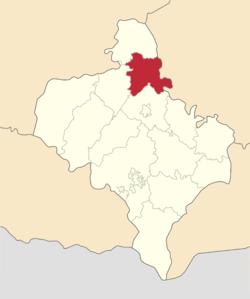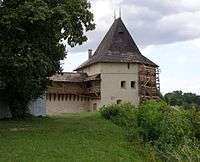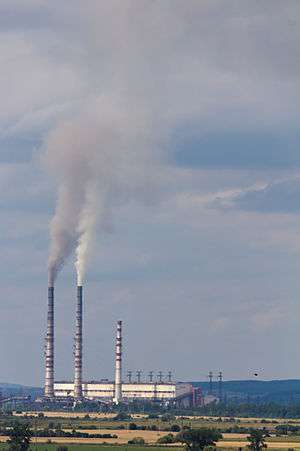Halych Raion
Halych Raion (Ukrainian: Галицький район) is a raion (district) of Ivano-Frankivsk Oblast (region) in Ukraine. The town of Halych serves as the administrative center of the district. Population: 44,217 (2016 est.)[1].
Halych Raion Галицький район | |
|---|---|
Raion | |
 | |
| Coordinates: 49°9′41″N 24°43′6″E | |
| Country | |
| Region | Ivano-Frankivsk Oblast |
| Established | ? |
| Admin. center | Halych |
| Subdivisions | List
|
| Government | |
| • Governor | Vasyl Kruk |
| Area | |
| • Total | 723 km2 (279 sq mi) |
| Population | |
| • Total | 44,217 |
| • Density | 61/km2 (160/sq mi) |
| Time zone | UTC+02:00 (EET) |
| • Summer (DST) | UTC+03:00 (EEST) |
| Postal index | 77104 |
| Area code | ? |
| Website | Raion Profile |
History
.jpg)

The Halych Raion was organized on January 20, 1940 soon after the Soviet invasion of Poland roughly from the Rohatyn and Stanisławów powiats of Stanisławów Voivodeship. From 1944 to 1962 the administrative center was located in the urban-type settlement of Burshtyn. In 1963 the territory of Bilshivtsi Raion (1940–1963) was brought under Halych administration. In 1993 Burshtyn received back its city status which it lost in 1942.
The current administrative center, the city of Halych, has long history. Prior to the mid-13th century it was the center of the once prominent Halych-Volyn Principality. In 1241 the city of Halych was destroyed during the Mongol invasion therefore the state capital was transferred to Kholm by the King Danylo Halytsky, while the destroyed Halych with the surrounding settlement was left as the bishop residence. Around this period the area was under series of conflicts involving the struggle between the Ruthenian factions as well as Kingdom of Poland, Kingdom of Hungary, Grand Duchy of Lithuania, and Golden Horde. In the 13th century the Halych Principality as part of the Ruthenian (Rus) Kingdom stretched from Przemyśl to Podolia, form Mukacheve to Terebovl, and from Busk to the Southern Bucovina.
By the end of the 13th century the Kingdom went into a heavy conflict with Lithuania, Poland, and Hungary with partial successes and failures. Upon the death of Lev I of Galicia the whole Kingdom went into decline due to a civil war. In 1323 the fall of the Polish-Ruthenian coalition against the Lithuanians the local boyars installed Boleslaw-Yuri II of Galicia. That move only strained the Ruthenian-Polish relationships which after short conflict ended the sovereignty of the Ruthenian Kingdom and the Halych Principality was annexed to the Kingdom of Poland in 1349. The partition of the Ruthenian Kingdom ensued the Galicia–Volhynia Wars as both Lithuania and Polish states fought for their expansion east. The new town of Halych was soon re-established in close proximity to the bishop's residence, receiving its Magdeburg Rights in 1367. Later its new castle was built sometime in the 16th century. By this time the area of the modern Halych Raion lost its importance and the town of Halych has become as any other small Polish towns.
According to the declaration of the Cabinet of Ministers of Ukraine of February 8, 1994 and the Presidential Order of October 11, 1994 in place of the old Halych (near the village of Krylos) was created the National preserve Ancient Halych. The preserve includes numerous churches, a system of defense structures, and various other historical artifacts of the ancient Ruthenian capital.
Administrative organization
Halych is the administrative center of the raion. The raion contains two cities of raion subordination meaning that both municipal councils of Halych and Burshtyn have equal power among each other. The Halych Raion is the only raion in Ivano-Frankivsk Oblast that has two cities while there are some raions that do not even have a single one.
The raion has a single urbanized settlement of Bilshivtsi that was established in 1940 after the annexation of the former Polish territory to the Soviet Union. The village of Slobidka Bilshivetska subordinated directly to that town.
The rest of settlements are rural and amount to 68 that are arranged into 38 rural municipalities (or communes for disambiguation purpose) that are governed by rural councils.
- Blyudnyky (Hannivtsi, Kurypiv, Pukasivtsi, Temyrivtsi)
- Bovshiv
- Bryn
- Vysochanka
- Viktoriv
- Deliyeve (Byshiv)
- Demeshkivtsi (Nimshyn, Poplavnyky, Prydnistrovia)
- Demianiv
- Dytyatyn (Naberezhne, Khokhoniv)
- Dorohiv (Kolodiiv)
- Dubivtsi
- Zhalybory
- Zadnistryanske
- Zalukva (Shevchenkove)
- Kinashiv
- Kinchaky (Kremydiv, Ozertse, Sadky)
- Komariv (Sokil)
- Korostovychi (Kuropatnyky)
- Krylos
- Kukilnyky (Zahiria-Kukilnytske)
- Kuriv
- Lany
- Mariyampil (Vodnyky)
- Medynya
- Medukha (Voronytsia)
- Mezhyhirtsi
- Nahraivka
- Nastashyne (Kunychi)
- Novi Skomorokhy (Stari Skomorokhy, Pidshumlyantsi)
- Ozeryany (Sloboda)
- Pelivtsi (Subotiv, Ostriv)
- Podillya
- Sapohiv
- Stary Martyniv (Rizdvyany)
- Tenetnyky (Novy Martyniv)
- Tumyr
- Tustan
- Yabluniv
The population of the whole raion is 65,640 with only 23,842 considered to be living in urban areas.
The major river that flows through the raion is Dniester river. There is also "Burshtyn Lake", around which are located four settlements Korostovychi, Bovshiv, Demianiv, and Burshtyn.
Location

The Raion is located in the north of the Ivano-Frankivsk Oblast. It borders with Tysmenytsia Raion in the south, Kalush Raion to the west, north of it there is Rohatyn Raion, and east of the Halych Raion lays Ternopil Oblast.
The major water supply for the raion is provided by the Dniester River. There is also located a Burshtyn Lake that sometimes referred to as a sea. Right next to the lake is located the Burshtyn TES.
Prominent people
- Denys Sichynsky (1865–1909), a composer and a conductor of Halychyna.
- Lavrentiy Zyzaniy (XVI - XVII), a pedagogue, writer, church activist.
References
- "Чисельність наявного населення України (Actual population of Ukraine)" (PDF) (in Ukrainian). State Statistics Service of Ukraine. Retrieved 19 July 2016.